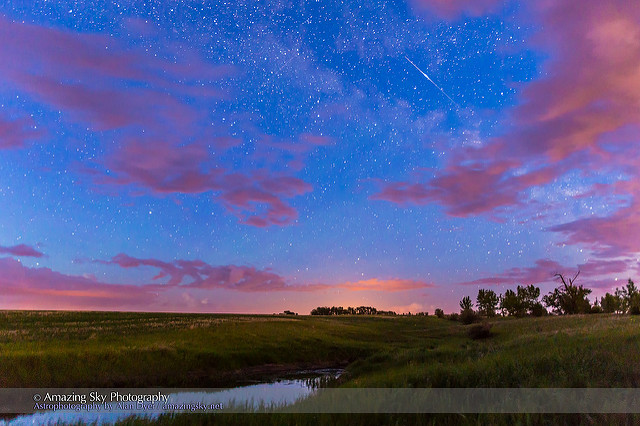

An Iridium flare slices through the twilight sky. Image credit and copyright: Alan Dyer.
You never forget your first one. I remember reading about a curious new set of flaring satellites, known as Iridiums. This was waaaaay back in the late 1990s, when we still occasionally read things in something called magazines, which involved pressing ink into plant-flesh to convey information.
Fast-forward to 2019, and the age of the predictable Iridium flare may be coming to an end. Already, scrolling through Heavens-Above reveals very few Iridium flares for the coming months, and these familiar nighttime flashes may become a thing of the past come the end of the decade in 2020.
The current spate of Iridium reentries have been coming nearly daily now. Looking at the Aerospace Cooperation’s reentry page shows Iridiums SV32, SV59, SV91 and SV14 have all reentered the Earth’s atmosphere in March 2019 alone, and Iridium-60 is due to reenter this weekend.
Launched in batches from 1997 to 2002, the constellation of 66 Iridium satellites plus 32 on-orbit spares and 4 dummy test masses was conceived by Motorola, and placed in low Earth orbit. At the time, the company envisioned that the constellation would pioneer the growth of personal satellite phone technology. In the end, however, the rise of cheap mobile phone towers worldwide at the turn of the millennium meant that satphone tech never really got past niche applications, such as emergency rescue and use by expeditions travelling to remote locations. Motorola’s Iridium company declared bankruptcy in 1999, and a group of private investors bought the constellation of satellites. Later, the control was taken up by Iridium Communications. The dream of accessible mobile communication worldwide may still come to pass, as OneWeb carried out its first successful launch in early 2019.
These satellites came with a perk for amateur satellite spotters: three large, refrigerator-sized reflective panels that could flare up to magnitude -8 when the Sun caught them just right. These sorts of specular flares are predictable, and soon, websites and later apps included these predictions. And heck, it was just plain fun at star parties to say “watch this patch of the sky, right about… now!” as a dependable Iridium flare appeared, right on time.
The Iridiums also made the news in 2009, when Iridium-33 collided with the defunct Kosmos-2251 satellite over Siberia. This was the first major collision between two satellites in orbit, and represented one of the largest debris-producing events in orbit in recent years.
The Rise of Iridium NEXT
The beginning of the end started in 2017, when Iridium Communications began launching its next generation of satellites, known as IridiumNEXT. Unfortunately, despite some early rumors on the SeeSat-L satellite tracking message board, the newer generation of IridiumNEXT satellites aren’t flare producers.
What’s the current status of the older constellation? Well, there are currently six dependable flare producers remaining as of March 15th: SVs -45, -54, -58, -61, -64, and -97. There are 25 more satellites that the company lost control of over the years that are currently defunct… unfortunately, flares from what remains of those are spurious, and aren’t predictable.
We cited 2019 as perhaps the last year that dependable Iridium flares will occur in our new book, The Universe Today’s Ultimate Guide to Viewing the Cosmos. Iridium CEO boss Matt Desch also mentioned to us that “we have approval for up to 10 (original) satellites with lower fuel levels to take up to 25 years for reentry… so last (Iridium flare) in 2043?” He also noted, though, that most of the remaining satellites will start tumbling after 2019.
Turns out, it’s hard to place a good, dedicated reflector in space. We’ve always thought it’s kind of ironic that some of the brightest and most dependable flaring satellites, such as the Iridiums, were never actually designed to do so. We’ve followed the latest spate of artistic reflector sats to include Mayak, Humanity Star, and Orbital Reflector… all of which turned out to be underwhelming, at best.
There are numerous platforms for tracking Iridiums across ye ole web, but observer beware… many of them are now actually tracking ‘ghost sats,’ as they’re not taking them out of the catalog as they reenter. Heavens-Above is a great tried and true resource, and it’s updated as the fleet of Iridium satellites diminishes over time.
Dedicated observers are chronicling the final days of the Iridium flares using the #flarewell hashtag on Twitter and the Catch the Iridium Project, which is urging viewers to see the final dependable flares, and just hit 1,000 images. Dedicated observer Ira Mollay also mentioned to us that are also two historical missing in action Iridiums, (SV 48 and SV 79) which failed shortly after launch in 2000 and 2001, which worth sleuthing out in archival images.
Who will capture the last Iridium flare? It’s strange to think that this fascinating era of satellite-spotting may soon be coming to an end.
When massive stars reach the end of their life cycle, they undergo gravitational collapse and…
Planets are born in swirling disks of gas and dust around young stars. Astronomers are…
Sometimes, things across the vast Universe line up just right for us. The Einstein Ring…
Our Sun is a giant plasma windbag spewing a constant stream of charged particles called…
Humanity will eventually need somewhere to live on the Moon. While aesthetics might not be…
How can a geologic map of a lunar impact crater created billions of years ago…